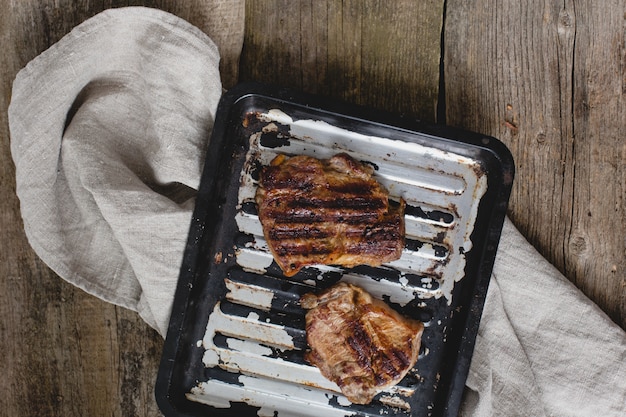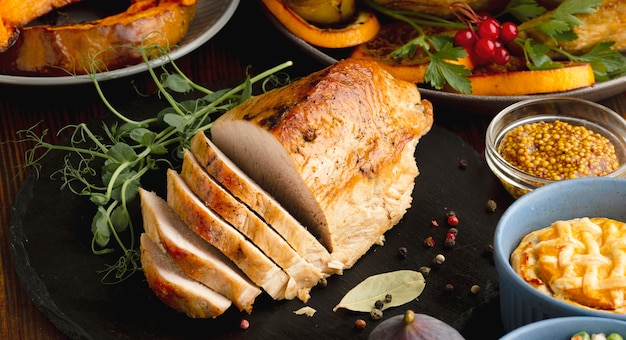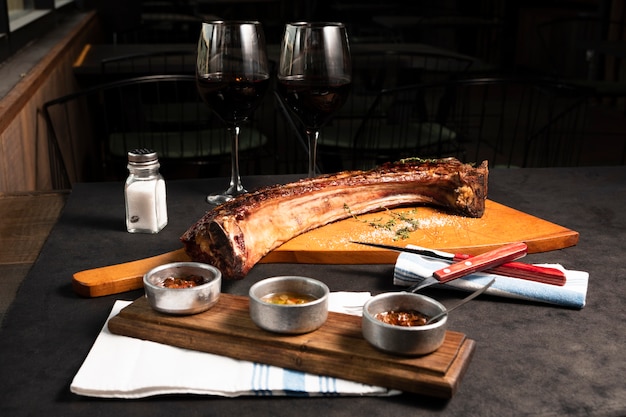Ah, the pork roast. A dish that's both impressive and deeply satisfying, and let's face it, it's a real crowd-pleaser. But getting that perfect, juicy, and tender result every time can feel like a bit of a culinary gamble, especially when it comes to knowing how long to cook it. You want it cooked through, but you also want to avoid a dry, overcooked mess.
Well, fear not, my fellow food enthusiasts! Over the years, I've learned a thing or two about pork roasts, and I'm here to share my secrets. We're going to dive deep into every aspect of cooking the perfect pork roast, from choosing the right cut to nailing those perfect timings. I'll even throw in some personal anecdotes and tips that I've picked up along the way. So grab a comfy chair, make yourself a cuppa, and let's embark on this culinary adventure together!
Part 1: Choosing the Perfect Cut

First things first, you need to choose the right cut of pork. This is like picking the right canvas for your masterpiece, and believe me, the choice can make a world of difference in terms of flavour and tenderness. Let's take a closer look at some of the most popular options.
The Mighty pork shoulder (Boston Butt)
Now, if you're asking me, the pork shoulder (also known as the Boston butt) is the king of the pork roast hill. It's a cut that's packed with flavour and incredibly versatile. The shoulder is known for its rich, marbled fat, which renders beautifully during cooking, resulting in a roast that's juicy, tender, and bursting with flavour. You can pull it apart for delicious sandwiches, slow-cook it for a melt-in-your-mouth experience, or even roast it whole with a crispy crackling. It's a real workhorse in the kitchen and a personal favourite of mine. Seriously, I've made so many incredible dishes with the pork shoulder; it's a true culinary champion.
The Lean and Delicate pork loin
If you're looking for a leaner cut with a more delicate flavour, the pork loin is a good choice. It's perfect for roasting whole or slicing into chops. The loin cooks relatively quickly and stays quite moist, but keep an eye on it, as it can dry out if overcooked. I remember one time when I was trying to impress my friends with a fancy pork loin roast, and I ended up overcooking it. Let's just say, it wasn't my finest culinary moment. So, learn from my mistake, and make sure you use a meat thermometer to avoid a dry, disappointing loin.
The Large and In Charge Pork Butt
Now, don't let the name fool you, the pork butt is actually part of the shoulder, and it's often confused with the Boston butt. It's simply a larger cut of the shoulder, perfect for feeding a crowd or those big family gatherings. The pork butt is known for its amazing flavour and tenderness, making it ideal for slow cooking. I love to use it for pulled pork sandwiches; they're a real hit with everyone. Just imagine, tender, juicy pulled pork piled high on soft buns, topped with your favourite sauce. It's pure comfort food bliss.
The Tender and Lean pork tenderloin
If you're after the most tender and lean cut of pork, then the tenderloin is the way to go. It's a bit more delicate than other cuts and is often used for grilling or pan-frying. It cooks quickly, so you'll want to keep a close eye on it to avoid overcooking. For a simple and elegant dish, try a seasoned tenderloin roasted with some roasted vegetables. It's a real crowd-pleaser and perfect for a special occasion.
Part 2: Preparing Your Pork Roast for Roasting Glory

Now that you've chosen your cut, it's time to get prepped. This step is crucial for ensuring a delicious and perfectly cooked roast. Think of it as getting your ingredients ready for a beautiful painting; a little prep work can go a long way.
Seasoning the Star of the Show
One of the joys of cooking pork is that it's incredibly versatile when it comes to seasoning. I love using simple blends of salt, pepper, and garlic powder, but you can also experiment with herbs, spices, and rubs. For a Mediterranean twist, I often use a blend of oregano, thyme, rosemary, and lemon zest. And if you're feeling a little adventurous, try a smoky paprika and chili powder mix for a kick of heat. Remember, the beauty of cooking is that you can really tailor the flavours to your liking. Just like a chef with a palate of colours, you can create your own masterpiece of flavour.
Choosing the Right roasting pan
The next step is to choose a roasting pan that's big enough for your pork roast. It should be big enough to accommodate the roast comfortably, with enough space for the fat to render. I personally prefer using a dutch oven, as it can go straight from the stovetop to the oven, but a standard roasting pan will work just fine. Just make sure it's big enough to comfortably hold your chosen pork roast.
Rendering that Beautiful Fat
For cuts like the pork shoulder that have a thicker layer of fat, I recommend scoring the skin. This helps the fat render more evenly and creates that fantastic, crispy crackling. You can score the skin by making shallow cuts across the surface, about half an inch deep. Don't be afraid to go a little deeper; it's the fat that adds flavour and keeps the meat moist, so don't be shy about letting it render! Just remember to be careful when handling sharp knives.
Part 3: The Art of Roasting

Now comes the moment of truth – the roasting itself! It's all about understanding the timings and maintaining the right temperature for a truly delicious result. Think of it as creating a delicate balance, like a painter adjusting the light and shadow in their masterpiece.
Finding the Perfect Oven Temperature
I generally roast my pork at a moderate temperature, around 325°F (160°C). This allows for a slow and even cooking process, resulting in a tender and juicy roast. I've tried roasting at higher temperatures, but it tends to dry out the meat. However, if you're short on time, you can increase the temperature to 350°F (175°C), but keep a close eye on it. Just remember that patience is key when it comes to roasting pork; it's not a race, it's a journey.
The Dance of Time and Temperature
The cooking time for your pork roast will vary depending on the size and thickness of the cut. Here's a handy table to guide you:
| Cut | Weight (lbs) | Cooking Time (at 325°F) |
|---|---|---|
| Pork Shoulder | 3-4 lbs | 2-2.5 hours |
| Pork Loin | 3-4 lbs | 1.5-2 hours |
| Pork Butt | 5-6 lbs | 3-3.5 hours |
| Pork Tenderloin | 1-2 lbs | 30-45 minutes |
Remember, these are just guidelines. The best way to determine if your pork roast is cooked through is by using a meat thermometer. Insert it into the thickest part of the roast, making sure it doesn't touch any bone. The internal temperature should reach 145°F (63°C) for safe consumption. It's a good idea to have a meat thermometer on hand; it's a culinary lifesaver.
Part 4: The Art of Basting and Resting
Okay, so your pork roast is in the oven, and the aroma is filling your kitchen. Now, here's where a little TLC comes in. As your roast cooks, basting it with pan juices or a flavorful glaze helps keep it moist and adds extra flavour. You can use a basting brush or simply spoon the juices over the roast. It's like giving your roast a little spa treatment, keeping it hydrated and looking its best.
Once your pork roast reaches the desired internal temperature, let it rest before carving. This allows the juices to redistribute throughout the meat, resulting in a more tender and flavourful roast. I usually recommend resting it for 15-20 minutes, covered with foil. Think of it as giving your roast a chance to unwind and settle in after its journey through the oven.
Part 5: Roasting Pork with a Crackling – A Culinary Masterpiece
Now, let's talk about that glorious crispy crackling! It's the pièce de résistance of any pork roast, and it's surprisingly easy to achieve. It's that perfect crunch that adds a whole new dimension to your roast, and it's a real crowd-pleaser. So, how do you get that beautiful, crispy crackling? Here's the secret:
For the best crackling, start by scoring the skin of your pork roast as mentioned earlier. Then, before roasting, rub the skin with salt. You can also add a bit of oil or lard for extra crispiness. During the last 30-45 minutes of cooking, increase the oven temperature to 400°F (200°C) to help the skin crisp up. Watch closely, as it can burn quickly. You'll know it's ready when it's golden brown and crackling. It's like watching a culinary masterpiece unfold right before your eyes.
Part 6: Leftovers and Storage – Making the Most of Your Pork Roast
So you've cooked up a storm of a pork roast, and you've got leftovers. Don't despair! Pork leftovers are fantastic for making sandwiches, salads, or even a delicious pork hash. You can even get creative and turn them into a hearty soup or stew. Leftovers are like a blank canvas for your culinary imagination.
To store your leftovers, let them cool completely at room temperature before transferring them to an airtight container. Store them in the refrigerator for up to 3-4 days. You can also freeze leftover pork roast for up to 3 months. To freeze, wrap the roast tightly in plastic wrap and then in aluminum foil. Defrost it overnight in the refrigerator before using.
Part 7: Variations and Tips – Elevating Your Pork Roast Game
Now that you've got the basics down, let's explore some variations and tips to elevate your pork roast game. Think of it as adding the finishing touches to your masterpiece, making it truly unique and unforgettable.
Glazing – Adding a Touch of Brilliance
Adding a glaze to your pork roast in the last 30 minutes of cooking can add a delicious burst of flavour and a beautiful sheen. You can use a simple honey glaze, a sweet and tangy cranberry sauce, or even a spicy chili glaze. My personal favourite is a maple-bourbon glaze – it's simply heavenly! It's like adding a touch of artistry to your roast, making it both delicious and visually stunning.
Stuffing – Adding Depth and Dimension
Stuffing your pork roast can add another dimension of flavour. You can use a traditional bread stuffing, a savoury herb stuffing, or even a fruit stuffing. Just make sure to stuff the roast loosely so it cooks evenly. Imagine the combination of textures and flavours; it's like a symphony for your taste buds.
Sides – The Perfect Accompaniment
No pork roast is complete without some delicious sides. Here are a few of my favourites:
- Roasted vegetables – add a medley of colours and flavours
- mashed potatoes – a classic comfort food pairing
- Gravy – rich and savory, perfect for drizzling over the roast
- green beans – a bright and fresh counterpoint to the richness of the roast
- Apple sauce – a sweet and tangy complement to the pork
Tips for Success – The Secret Sauce to Perfect Pork
- Don't overcrowd your roasting pan. If you're cooking a large roast, it might be best to cook it in two batches. Allowing the roast to breathe in the oven ensures even cooking.
- Use a meat thermometer to ensure the internal temperature reaches 145°F (63°C). It's the best way to guarantee a safe and perfectly cooked roast. It's like having a culinary compass to guide you.
- Rest your pork roast for 15-20 minutes before carving. This allows the juices to redistribute, resulting in a more tender and flavourful roast. It's a little bit of patience that pays off big time.
- Don't be afraid to experiment with different seasonings and glazes. Pork is incredibly versatile, so there's no limit to what you can create. Let your culinary creativity run wild!
Part 8: A Simple and Delicious pork shoulder roast Recipe
Here's a simple and delicious recipe for a pork shoulder roast with a crispy crackling, using some of the tips we've discussed:
Ingredients:
- 3-4 lb pork shoulder roast
- 1 tbsp salt
- 1 tsp black pepper
- 1 tsp garlic powder
- 1 tbsp olive oil
Instructions:
- Preheat oven to 325°F (160°C). Getting your oven preheated is crucial for ensuring even cooking.
- Score the skin of the pork shoulder with a sharp knife, making shallow cuts about half an inch deep. This allows the fat to render evenly and helps create that crispy crackling. Remember to be careful with sharp knives.
- Rub the pork shoulder with salt, pepper, and garlic powder. This simple seasoning blend adds a lovely depth of flavour to the roast.
- Place the pork shoulder in a roasting pan and drizzle with olive oil. The olive oil helps to keep the roast moist and adds a touch of richness.
- Roast for 2-2.5 hours, or until the internal temperature reaches 145°F (63°C). Use a meat thermometer to ensure it's cooked through.
- Increase the oven temperature to 400°F (200°C) for the last 30 minutes of cooking to crisp up the skin. This creates that beautiful, crispy crackling we've all been waiting for.
- Let the pork roast rest for 15-20 minutes before carving. Allowing the roast to rest helps the juices redistribute, resulting in a more tender and flavourful roast.
Part 9: FAQs – Answering Your Burning Pork Roast Questions
Now, let's answer some common questions about pork roast cooking, so you can feel confident in your culinary skills.
1. How do I know if my pork roast is cooked through?
The best way to determine if your pork roast is cooked through is by using a meat thermometer. Insert it into the thickest part of the roast, ensuring it doesn't touch any bone. The internal temperature should reach 145°F (63°C) for safe consumption. It's a simple and reliable way to ensure your pork is cooked to perfection.
2. What happens if I overcook my pork roast?
Overcooking a pork roast will result in a dry and tough roast. It's best to err on the side of undercooked, as you can always cook it a little longer if needed. But remember, once it's overcooked, there's no turning back.
3. Can I cook pork roast in a slow cooker?
Yes, you can cook a pork roast in a slow cooker. It's a great way to get a tender and flavourful roast. Just make sure to season it well and cook it on low for 6-8 hours, or on high for 3-4 hours. The slow cooker does all the work for you, resulting in a truly melt-in-your-mouth roast.
4. Can I reheat leftover pork roast?
Yes, you can reheat leftover pork roast. You can reheat it in the oven, on the stovetop, or in the microwave. Just be sure to heat it through to an internal temperature of 165°F (74°C) to ensure it's safe to eat. You can even add a little bit of broth or sauce to the reheating process to keep it moist and flavourful.
5. What are some other ways to cook pork roast?
Pork roast can also be cooked in a pressure cooker, grilled, or smoked. Each method results in a unique flavour and texture. So, get creative and experiment with different cooking methods to discover new and exciting flavours.
And there you have it! You're now armed with the knowledge and tips to become a pork roast master. So grab a juicy cut, season it generously, and get ready to impress your family and friends with your perfectly cooked pork roast. Happy cooking!
Everyone is watching

Corn on the Cob: The Ultimate Guide to Perfectly Cooked Ears
Healthy MealsAh, corn on the cob. Just the name evokes images of sunny days, barbecues, and that sweet, juicy flavour that ...

Scallops: The Ultimate Guide to Perfect Cooking
Healthy MealsAh, scallops. Those delicate, sweet, and utterly delicious morsels of the sea. They hold a special place in my...

Spaghetti Squash: The Ultimate Guide to Cooking and Serving
Healthy MealsRemember that time you saw spaghetti squash at the supermarket, looking all bumpy and strange, and thought, "W...

Salmon Cooking Times: Perfect Guide for Every Recipe
Healthy MealsLet me tell you, cooking salmon is an art form. It's all about getting that perfect balance: juicy and tender,...

Ham Cooking Time: How Long to Bake, Smoke, or Boil a Delicious Ham
Healthy MealsAh, ham. It's a classic, isn't it? A real crowd-pleaser, especially around holidays. And when done right, it'...
